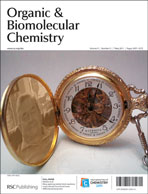Translocation versus cyclisation in radicals derived from N-3-alkenyl trichloroacetamides
Abstract
Under radical reaction conditions, two different and competitive reaction pathways were observed for N-(α-methylbenzyl)trichloroacetamides with a N-3-cyclohexenyl substituent: 1,4-hydrogen translocation and radical addition to a double bond. However, for radicals with an acyclic


 Please wait while we load your content...
Please wait while we load your content...